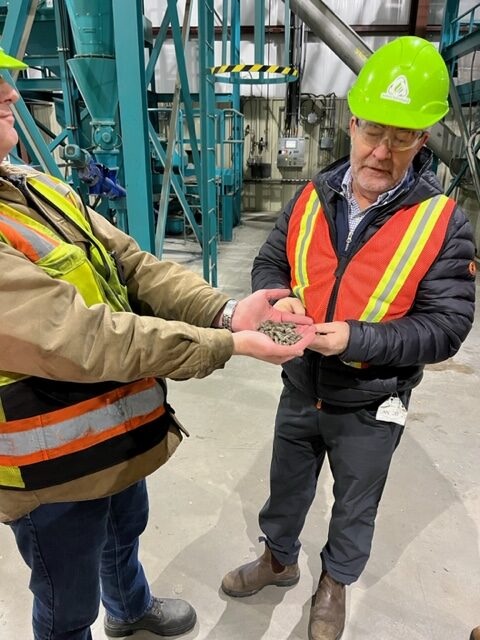
In-Depth
Opinion: Repurposing municipal solid waste for bioeconomy benefits
February 23, 2023
By Tristin Mabey

Across the country, approaches are being sought to become more sustainable and achieve carbon neutrality. Achieving net-zero emissions by 2050 is an ambitious but attainable goal with technology advancements and cross-industry collaboration.
A viable option to reduce the country’s reliance on fossil fuels is to transition to a renewable natural resource such as biomass. Harvesting of biomass typically involves wood and agricultural products, but in Chester, N.S., the team at Sustane Technologies is looking at the production a bit differently – by using municipal solid waste.
Alternative biomass harvesting
Sustane Technologies is a clean-technology company. They have taken patented separation technologies and integrated these with other known technologies into a complete holistic process. Sustane has built the first commercial-scale facility capable of converting up to 70,000 tonnes of municipal solid waste (MSW) annually. This will result in over 90 per cent of materials being diverted from landfills and into value-added products upon full ramp-up of the facility.
Producing biomass from MSW has positive rippling effects on the local municipality; the extended lifespan of landfills, value-added products from waste, healthier communities, high-quality jobs and more. The MSW received at Sustane is waste collected after recycling and organic separation by householders at the roadside. The Sustane operation repurposes this waste into useful, value-added raw materials.
The Sustane way
The first North American Sustane commercial demonstration facility operates in the Municipality of Chester in Nova Scotia. At the facility, MSW from Chester and neighbouring municipalities is separated using patented technologies to remove metallic and other pieces of non-organic materials. The remaining mass of material is primarily organic. It is processed using a patented thermal conditioning system, which breaks down the organic biomass, allowing the density difference of any remaining small and micro-sized plastics within the stream to separate.
The different material streams are now ready for transformation into products and energy. A small portion of the downstream energy produced from waste is in turn used to supply the energy to the plant to run the entire process, so fully self-SUSTANE-able!
The organic portion of material that has passed through all the separation processes is transported to a dryer, and further processed into uniform biomass pellets. They are now ready for use in different energy markets. The plastics stream is converted through pyrolysis into two grades of synthetic fuels. One grade is suitable as fuel and the other is suitable potentially as feedstock to produce higher-value polymers, thus achieving full material circularity. The waste stream valorization produces a revenue stream, also an important part of the Sustane-able model.

Biomass pellets produced at the Sustane Tech facility. Photo: BioApplied.
The Nova Scotian advantage
Nova Scotia is a leading province in MSW management, and with the deployment of Sustane’s patented technologies, it has the potential to begin eliminating local landfills, improve the overall health of communities, and boost the bioeconomy. Sustane is supported by public and private partners in Nova Scotia, including the Nova Scotia Innovation Hub (NSIH), a not-for-profit organization supporting bioeconomy firms on their path to commercialization.
The NSIH works to foster collaboration with a range of enterprises, entrepreneurs, feedstock suppliers, industry partners and members of government to advance Nova Scotia’s bioeconomy. Cross-collaboration between non-traditional industries facilitates new ideas, value-added synergy, and supply-chain integration. It is one of the many factors by which the Nova Scotia bioeconomy stands out and begins to flourish.
Achieving net-zero
Biomass pellets produced using Sustane’s technologies are carbon neutral, offering a competitive advantage for end-users. But the benefits don’t stop there. For every tonne of garbage that comes to the Chester landfill, its carbon emissions are reduced by 2.5 tonnes – that’s equal to 40,000 cars taken off the road. Achieving a more circular economy supports the goal of reaching net-zero emissions, and that’s something we can all support.
The bioeconomy is a regenerative system that works together to repurpose and reuse renewable bioresources. Sustane’s operations are a shining example of what is possible when people work together to make the world a more sustainable place to live. There is an enormous quantity of solid waste generated each and every day around the world. Likewise, there are an abundant number of landfill sites within communities similar to Chester. Will your community be next?
Editor’s note: Read our 2020 profile on Sustane Technologies here.
 Tristin Mabey is the communications and administrative associate at BioApplied, a consulting firm that specializes in helping clients develop and deploy advanced technologies in renewable resource sectors. Sharing successes and opportunities within the bioeconomy is what fuels Tristin’s passion for the industry.
Tristin Mabey is the communications and administrative associate at BioApplied, a consulting firm that specializes in helping clients develop and deploy advanced technologies in renewable resource sectors. Sharing successes and opportunities within the bioeconomy is what fuels Tristin’s passion for the industry.
Print this page